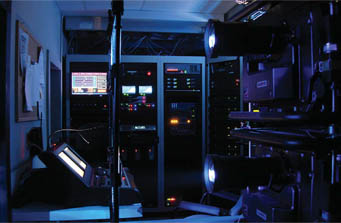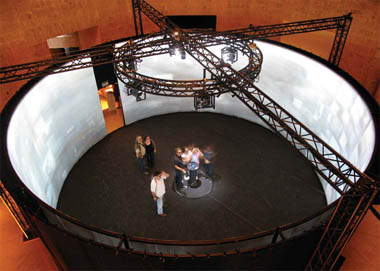What The New Video Dimension Means For AV This month,
Scientific visualization has become one of projectiondesign’s most important markets. 150 million pairs of 3D glasses are going to be given away in time for the SuperBowl. They will not, however, be intended for use during the game itself—which will be broadcast, as usual, in two dimensions. The great glasses giveaway is a promotion by DreamWorks Animation, which hopes to persuade football fans that they should go out and see its latest picture, Monsters vs. Aliens, soon to be showing in 3D at a movie theater (fairly) near you.
In addition to the cost of giving away the glasses, which DreamWorks CEO Jeffrey Katzenberg estimates at “tens of millions of dollars”, the company has also had to pay for airtime and for a special 90-second commercial to be made for broadcast during the SuperBowl. The trailer will be perfectly viewable in 2D, but DreamWorks hopes that as many viewers as possible will have their free glasses to hand alongside their TV remote, mobile phone, and beer bottle.
Why such a big push for 3D now? Well, Hollywood studios are investing hundreds of millions of dollars in producing new movies in three dimensions. The New York Times estimated in a story this month that Disney alone has 15 3D movies in its production pipeline; other studios are working on at least as many again. Filming in 3D typically adds around $15 million to production costs, but studios can easily make that back— and much more—by charging premium prices at the box office.

Digital Projection is launching a new range of 3D projectors into the commercial AV market at the end of this month. One of the first permanent homes for DPI’s new 3D product was the Dollywood theater projection room. Yet, just as with digital cinema, the transition to 3D is being hampered by the customary bickering between studios, film distributors, and theater owners as to who should foot the bill for the $100,000 or so it costs to upgrade each screen. So, while movie industry luminaries such as DreamWorks’ Katzenberg foresee a time when all new feature films will be shot in 3D, the reality is that, for the foreseeable future, there will have to be 2D versions of movies such as Monsters vs. Aliens available if they are to get the breadth of distribution they need.
Which is not to say that all the fuss currently being made about 3D is irrelevant to the integrator community. On the contrary, professional AV has, if anything, a bigger field on which to play than mere moviegoing. As Digital Projection prepares to launch a whole new range of 3D projectors into the commercial AV market at the end of this month, its president, Mike Levi, paints a pretty clear picture on how the market for 3D has changed over the past few years. “Historically, 3D meant entertainment,” Levi said. “It was cinema, it was a museum or it was a theme park. Most of the requests we had for 3D would be for short films that were to be projected onto a big screen in a big auditorium. Those applications tended to need two projectors anyway, in order to get the brightness right. So we could always do passive 3D with two projectors.
“Then, about three years ago, our channel started to take us into other markets: scientific, medical, military, oil and gas, anything that involves the very close study of objects. These vertical markets were becoming very interested in 3D visualization, and it was clear the demand was there. That was when we started to think about what our active stereo 3D products might look like, and what they would offer our customers.”
Another hardware manufacturer to have recently embraced active 3D is Norway’s projectiondesign, which debuted its F10 AS3D portable projection system to wide acclaim at last year’s InfoComm. The company’s marketing communications manager, Anders Løkke, says that scientific visualization has become one of its most important markets. Equally, though, he is keen not to dismiss the significance of consumer promotions such as DreamWorks’ SuperBowl venture.
“We see 3D in terms of three different quality levels,” Løkke explained. “At the low end, there’s anaglyphic 3D with the old-style red/cyan glasses, along with the new ColorCode 3D system, which is the one DreamWorks will be using for their 90-second trailer. These systems don’t give a great experience, but they are important because they raise consumer awareness of 3D, and if that pulls people into movie theaters, it will be good for us.
“The middle range is where you stack one projector on top of another and you polarize them so that one handles the horizontal while the other does the vertical, or you use something like the Infitec system where you suck out a part of the color spectrum for each eye. These approaches are useful for larger groups but they have some drawbacks in terms of light loss and color loss, and you also need a polarizing screen.
“Finally, at the high end would be active stereo for immersive environments such as CAVEs, where you use multiple rear-projection screens. The price goes up—the glasses from Real D are around $700, so they’re never going to be a SuperBowl giveaway— but so does the quality.”
SCREEN TIME
For the end customer, the attractions of immersive 3D environments are clear. They reduce the time it takes for hard-pressed car manufacturers, for example, to get new models to market. And they enable the military to train personnel on the use of new equipment without the need to create a physical ‘theater’.
For the integrator, though, this application throws up a number of key technical considerations. As Digital Projection’s Levi pointed out: “Typically, in the 3-chip DLP world, there are two specs that we talk about, namely native resolution and lumens. In commercial AV, people pay more money for brightness when they have large screens to project onto. But immersive applications, where ambient light levels are very controlled, are more like a home theater, where contrast is actually more important. If you have too many lumens, you get a lot of light coming off every screen that can result in crosstalk that is very detrimental to the application. A better solution is to improve the dynamic range and lower the black level through increased contrast. A lower black level conveys a much better sense of that third dimension.”
Levi added that the amount of specialist knowledge required to design and install for 3D visualization varies enormously, depending on how much the end customer is doing for themselves. “If the end user is already generating their own content and all they need is distribution and display, then the learning curve is not difficult,” Levi said. “But there are a number of customers who are looking for more than a display. They may be looking for content and help with the image generation, and in those applications, most of the work is going to go to specialist integrators who already in visualization and simulation.”
Anders Løkke noted that while the advent of self-contained, singleprojector stereo solutions with familiar user interfaces has made one part of the integrator’s job easier, not every link in the chain can be relied upon to be straightforward. “The problem I see is serving up the content and media. There’s no standard computer platform for it. We’ve seen Autodesk’s new Maya, which is ready to make 3D straight out of the box, and that will be interesting. And during 2009 we’ll be going to a few shows where live 3D CAD drawing is going to be demonstrated, and that will be a big leap forward.”
IN PRODUCTION
The very idea of virtual reality as a spontaneous entity may seem incongruous to many. After all, doesn’t all that CGI in those DreamWorks and Disney movies (not to mention computer games) take millions of man-hours to create? Up until now, it has. But new technology is making it easier for virtual environments to be created, for everything from TV commercials to live corporate events.
Earlier this month, PSP AV used London’s Royal Academy as the launch platform for Animotion Live, a new motion-capture system designed to streamline the process of both 2D and 3D animated image creation. “In movie production, what happens is they capture a person’s body movement as one data stream, hand movement as another, head movement as another, and then in post-production they bring all those elements together,” says David Woodcock, account manager, Animotion.
“For a movie like Shrek, they will do those different elements and then stitch them together in post-production, and that creates a huge postproduction pipeline of around 30 people on each of those elements. The quality of the results is very accurate, but below that level, in regular video production, advertising, and live events, these systems are hugely expensive. So what we’ve come up with is a way in which all these streams are captured in real time, and all integrated together. So at a live event, for example, you’ve got a real character that can interact with you.”
Perhaps more than any other integration marketplace, 3D needs both the right quality and the right quantity of content if it is to keep on growing. With Hollywood’s huge financial commitment at one end of the scale, and innovations such as Animotion Live at the other, the content issue looks as though it is finally being addressed at a number of different levels.
At the end of this month, 150 million Americans will get the chance to see just how far 3D has come. The floodgates of this brave new market may not yet be fully open but, thanks to the efforts of content producers, enlightened AV manufacturers and pioneering integrators, the lock has been successfully picked, and a chink of light is appearing. What happens next could be very big indeed.
